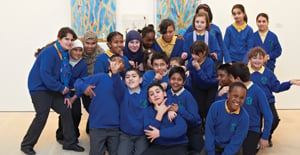A cultural entitlement
Jeremy Newton argues that arts education should not be left by the wayside as the curriculum is overhauled

From the first Theatre in Education activity in the 1960s up to the Creative Partnerships and Find Your Talent schemes of more recent vintage, the UK has developed a strong track record of experimentation and innovation in the field of arts education and outreach. Sadly, the one thing that these interventions have singularly and consistently failed to do across four or five decades is to have the slightest impact on the socio-economic mix of arts audiences. The education of generations of children has no doubt been enriched by all this activity, but whether or not these children grow up to become regular visitors to theatres, galleries, museums and concert halls continues to be dictated by their family background and economic status. Time spent making up for deficiencies in our mainstream education system has been time spent failing to develop the kind of ‘new audiences’ for the arts which we have (in theory) been pursuing.
No doubt there are multiple reasons for this failure, including too many one-off initiatives and not enough sustained engagement over several years; too much emphasis on participation to the exclusion of nurturing critical appreciation; too much activity in schools and not enough in cultural venues. These are not necessarily authoritative or comprehensive explanations. Others have argued, equally plausibly, that the drive to ‘widen audiences’ is essentially a doomed project – by their very nature, the arts (it is suggested) will always ‘exclude’ a significant proportion of those with the lowest levels of educational attainment. Much as my instincts rebel against such a counsel of despair, it can’t be denied that the aspiration to engage all sectors of society in the arts cannot be uncoupled from a broader educational agenda related to under-performance, under-achievement and disadvantage.
The Prince’s Foundation for Children and the Arts develops and supports clusters of activity across the UK. All our work is targeted at ‘disadvantaged’ children of all kinds – those eligible for free school meals, those with special needs, those with the misfortune to attend ‘failing schools’, and so on. A recent Organisation for Economic Co-operation and Development study compared the likelihood of disadvantaged children in a large number of developed countries overcoming the obstacles and achieving educational qualifications and gaining employment. The UK fares very badly – far worse than the USA, most of Europe and most of Asia. The report concludes that the root causes of under-performance are low self-confidence and self-esteem, and poor communication skills.
Needless to say, the arts are probably better placed than any other form of activity to address these issues. Countless evaluations (both of our own projects and of others) testify to the importance of learning outside the classroom, where children can experiment with new experiences, express their ideas and feelings, and relate to their peers and to adults in a new way, within an environment which is non-threatening, inspiring and fun.
A fresh approach to the arts in (and out of) schools is urgently needed. Two important Government reviews currently underway are at risk of pulling in opposite directions. Darren Henley’s Review of Cultural Education for the DCMS and the Department for Education (DfE) will, we all firmly hope, make timely claims for the importance of culture at all stages of formal schooling and the need to ensure that the arts are fully incorporated into the national curriculum (though, perversely, Henley’s brief warns him off discussing the position of the arts in the curriculum). Simultaneously, the DfE is reviewing that very national curriculum with a clear mandate from Michael Gove to look for ways to narrow the range of subjects included. The arts are a likely casualty. Teachers struggling to haul their school up the literacy and numeracy targets ladder are very likely to utilise any flexibility to dilute or even eliminate arts education in favour of the core curriculum of English, maths and science (with a bit of PE). Sadly, this seems likely to be the case even in the face of Ofsted-validated evidence that the best performing and most rapidly improving schools are those which prioritise breadth as firmly as depth in their curriculum offer.
At secondary level, the advent of the English Baccalaureate (or E-Bacc) may have a similarly damaging effect. Establishing a curriculum of English, maths, two sciences, a foreign language and either history or geography as the norm for study up to GCSE level (and the qualifying structure for the E-Bacc) means that, again, teachers are likely to increasingly form plans around these subjects, and there is already evidence of this process unfolding. Once again, subjects such as music, drama and art & design are squeezed out.
The argument for breadth and balance in the curriculum, at all stages, needs to be maintained. Just as importantly, though, and perhaps more pragmatically, it remains the case that well-planned and structured visits to theatres and museums, for example, can have a transformational impact on children who otherwise struggle to find a way into the formal curriculum, and this is true whether they’re linked to (and justified by) the study of English and history or to subjects like drama or art. Integrating a rich experience of high-quality performances and exhibitions into formal education at all ages is, in fact, too important to be left to the vagaries of whatever core curriculum happens to be in fashion at any particular time. It should be a permanent entitlement of every child.
Join the Discussion
You must be logged in to post a comment.